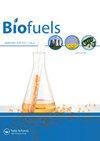Comparative assessment of biochar produced from LDPE and neem leaves using batch and semi-batch biomass fuel-based reactors
IF 2.6
4区 工程技术
Q3 ENERGY & FUELS
引用次数: 0
Abstract
AbstractThis research aims to investigate and compare the properties of biochar derived from low-density polyethylene (LDPE) and neem leaves, utilizing both batch and semi-batch biomass fuel-based reactors for co-carbonization. While previous studies have primarily employed electrical-powered or biomass fuel-based batch reactors, this study introduces the innovative approach of utilizing a semi-batch reactor, marking a significant advancement in biochar production. The co-carbonization process lasted for ∼2 h in the batch-based system and nearly 3 h in the semi-batch system. The semi-batch system achieved higher temperature peaks in comparison to the batch-based system. In terms of biochar yield, the batch-based system generated a biochar yield of 30.35%, while the semi-batch system yielded 17.3%. Through BET analysis, it was determined that the biochar produced using the semi-batch reactor had a surface area of 227 m2/g and a pore diameter of 2.116 nm. Similarities and differences in functional groups among the biochar samples produced using the semi-batch and batch reactors were identified through FTIR analysis. By utilizing EDX spectroscopy, it was observed that the batch-based system contained seven elements, whereas the semi-batch-reacted sample had similar elements but lacked nitrogen, potassium, and magnesium. The semi-batch-reacted sample exhibited an increased carbon content, whereas the concentrations of other elements decreased when compared to the batch-reacted sample. The biochar samples can be applied in various applications, including water treatment, energy conversion, and storage. The findings of this study contribute to sustainable waste management practices, carbon sequestration efforts, and the development of innovative solutions for various industries.Keywords: Batch reactorcharacterizationenergy utilizationgasificationgreen chemistrysemi-batch reactor Author contributionsKingsley O. Iwuozor: conceptualization, data curation, formal analysis, investigation, methodology, validation, visualization, roles/writing—original draft, writing—review and editing. Ebuka Chizitere Emenike: conceptualization, data curation, formal analysis, investigation, methodology, validation, visualization, writing—review and editing. Joy Adeleke: conceptualization, data curation, formal analysis, investigation, methodology, validation, visualization, writing—review and editing. Taiwo Temitayo Micheal: validation, visualization, roles/writing—original draft, writing—review and editing. Ogunniyi Samuel: validation, visualization, roles/writing—original draft, writing—review and editing. Adewale George Adeniyi: conceptualization, data curation, formal analysis, investigation, methodology, supervision, validation, visualization, writing—review and editing.Disclosure statementNo potential conflict of interest was reported by the author(s).Additional informationFundingThis work received no external funding.利用间歇和半间歇生物质燃料反应器对LDPE和印楝叶生产的生物炭进行比较评估
摘要本研究旨在研究和比较低密度聚乙烯(LDPE)和印楝叶制备的生物炭的性能,利用间歇和半间歇生物质燃料反应器进行共碳化。虽然以前的研究主要采用电力或生物质燃料间歇反应器,但本研究引入了利用半间歇反应器的创新方法,标志着生物炭生产的重大进步。共碳化过程在间歇体系中持续了~ 2小时,在半间歇体系中持续了近3小时。与基于批处理的系统相比,半批处理系统实现了更高的温度峰值。在生物炭产率方面,间歇体系的生物炭产率为30.35%,而半间歇体系的生物炭产率为17.3%。通过BET分析,确定半间歇反应器生产的生物炭的比表面积为227 m2/g,孔径为2.116 nm。通过FTIR分析,确定了半间歇反应器和间歇反应器生产的生物炭样品中官能团的异同。利用EDX光谱分析发现,批反应体系中含有7种元素,而半批反应样品中含有类似元素,但缺少氮、钾和镁。与批量反应样品相比,半批量反应样品的碳含量增加,而其他元素的浓度降低。生物炭样品可以应用于各种应用,包括水处理、能量转换和储存。这项研究的结果有助于可持续的废物管理实践,碳封存工作,以及为各行业开发创新的解决方案。关键词:间歇反应器表征能源利用气化绿色化学半间歇反应器作者贡献:概念化,数据管理,形式分析,调查,方法论,验证,可视化,角色/写作-原始草稿,写作-审查和编辑。Ebuka Chizitere Emenike:概念化,数据管理,形式分析,调查,方法论,验证,可视化,写作-审查和编辑。Joy Adeleke:概念化、数据管理、形式分析、调查、方法论、验证、可视化、写作审查和编辑。Taiwo Temitayo michael:验证,可视化,角色/写作-原稿,写作-审查和编辑。Ogunniyi Samuel:验证,可视化,角色/写作-原稿,写作-审查和编辑。Adewale George Adeniyi:概念化、数据管理、形式分析、调查、方法论、监督、验证、可视化、写作-审查和编辑。披露声明作者未报告潜在的利益冲突。本工作未获得外部资助。
本文章由计算机程序翻译,如有差异,请以英文原文为准。
求助全文
约1分钟内获得全文
求助全文
来源期刊

Biofuels-Uk
Energy-Renewable Energy, Sustainability and the Environment
CiteScore
5.40
自引率
9.50%
发文量
56
期刊介绍:
Current energy systems need a vast transformation to meet the key demands of the 21st century: reduced environmental impact, economic viability and efficiency. An essential part of this energy revolution is bioenergy.
The movement towards widespread implementation of first generation biofuels is still in its infancy, requiring continued evaluation and improvement to be fully realised. Problems with current bioenergy strategies, for example competition over land use for food crops, do not yet have satisfactory solutions. The second generation of biofuels, based around cellulosic ethanol, are now in development and are opening up new possibilities for future energy generation. Recent advances in genetics have pioneered research into designer fuels and sources such as algae have been revealed as untapped bioenergy resources.
As global energy requirements change and grow, it is crucial that all aspects of the bioenergy production process are streamlined and improved, from the design of more efficient biorefineries to research into biohydrogen as an energy carrier. Current energy infrastructures need to be adapted and changed to fulfil the promises of biomass for power generation.
Biofuels provides a forum for all stakeholders in the bioenergy sector, featuring review articles, original research, commentaries, news, research and development spotlights, interviews with key opinion leaders and much more, with a view to establishing an international community of bioenergy communication.
As biofuel research continues at an unprecedented rate, the development of new feedstocks and improvements in bioenergy production processes provide the key to the transformation of biomass into a global energy resource. With the twin threats of climate change and depleted fossil fuel reserves looming, it is vitally important that research communities are mobilized to fully realize the potential of bioenergy.
 求助内容:
求助内容: 应助结果提醒方式:
应助结果提醒方式:


